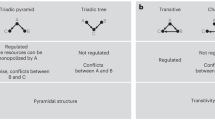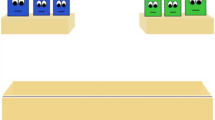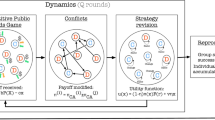Abstract
Social hierarchies occur across human societies, so all humans must navigate them. Infants can detect when one individual outranks another1,2,3, but it is unknown whether they approach others based on their social status. This paper presents a series of seven experiments investigating whether toddlers prefer high- or low-ranking individuals. Toddlers aged 21–31 months watched a zero-sum, right-of-way conflict between two puppets, in which one puppet ‘won’ because the other yielded the way. Of the 23 toddlers who participated, 20 reached for the puppet that ‘won’. However, when one puppet used force and knocked the other puppet down in order to win, 18 out of 22 toddlers reached for the puppet that ‘lost’. Five follow-up experiments ruled out alternative explanations for these results. The findings suggest that humans, from a very early age, not only recognize relative status but also incorporate status into their decisions about whether to approach or avoid others, in a way that differs from our nearest primate relatives4.
This is a preview of subscription content, access via your institution
Access options
Access Nature and 54 other Nature Portfolio journals
Get Nature+, our best-value online-access subscription
$29.99 / 30 days
cancel any time
Subscribe to this journal
Receive 12 digital issues and online access to articles
$119.00 per year
only $9.92 per issue
Buy this article
- Purchase on Springer Link
- Instant access to full article PDF
Prices may be subject to local taxes which are calculated during checkout




Similar content being viewed by others
References
Thomsen, L., Frankenhuis, W. E., Ingold-Smith, M. & Carey, S. Big and mighty: preverbal infants mentally represent social dominance. Science 331, 26–29 (2011).
Pun, A., Birch, S. A. J. & Baron, A. S. Infants use relative numerical group size to infer social dominance. Proc. Natl Acad. Sci. USA 113, 2376–2381 (2016).
Mascaro, O. & Csibra, G. Representation of stable social dominance relations by human infants. Proc. Natl Acad. Sci. USA 109, 6862–6867 (2012).
Krupenye, C. & Hare, B. Bonobos prefer individuals that hinder others over those that help. Curr. Biol. 28, 280–286 (2018).
Fiske, A. P. The four elementary forms of sociality: framework for a unified theory of social relations. Psychol. Rev. 99, 689–723 (1992).
Hawley, P. H. The ontogenesis of social dominance: a strategy-based evolutionary perspective. Dev. Rev. 19, 97–132 (1999).
van Vugt, M. & Tybur, J. M. in The Handbook of Evolutionary Psychology (ed. Buss, D. M.) 1–40 (John Wiley & Sons, Hoboken, NJ, 2014).
Pratto, F., Sidanius, J. & Levin, S. Social dominance theory and the dynamics of intergroup relations: taking stock and looking forward. Eur. Rev. Soc. Psychol. 17, 271–320 (2006).
Henrich, J. The Secret of Our Success: How Culture is Driving Human Evolution, Domesticating Our Species, and Making Us Smarter (Princeton Univ. Press, Princeton, NJ, 2015).
Magee, J. C. & Galinsky, A. D. Social hierarchy: the self reinforcing nature of power and status. Acad. Manag. Ann. 2, 351–398 (2008).
Huntingford, F. A. Animal Conflict (Springer Science & Business Media, Chapman and Hall, New York, NY, 2013).
Smith, J. M. & Price, G. R. The logic of animal conflict. Nature 246, 15–18 (1973).
Hunt, J. & Simmons, L. W. Status-dependent selection in the dimorphic beetle Onthophagus taurus. Proc. R. Soc. B Biol. Sci. 268, 2409–2414 (2001).
Grosenick, L., Clement, T. S. & Fernald, R. D. Fish can infer social rank by observation alone. Nature 445, 429–432 (2007).
Sapolsky, R. Social status and health in humans and other animals. Annu. Rev. Anthropol. 33, 393–418 (2004).
von Rueden, C. R. & Jaeggi, A. V. Men’s status and reproductive success in 33 nonindustrial societies: effects of subsistence, marriage system, and reproductive strategy. Proc. Natl Acad. Sci. USA 113, 10824–10829 (2016).
Cummins, D. in The Handbook of Evolutionary Psychology (ed. Buss, D. M.) 676–697 (John Wiley & Sons, Hoboken, NJ, 2006).
Thomsen, L. & Carey, S. in Navigating the Social World: What Infants, Children, and Other Species Can Teach Us (eds Banaji, M. R. & Gelman, S. A.) 17–22 (Oxford Univ. Press, New York, NY, 2013).
Fiske, A. P. & Rai, T. S. Virtuous Violence (Cambridge University Press, Cambridge, 2014).
Henrich, J. & Gil-White, F. J. The evolution of prestige: freely conferred deference as a mechanism for enhancing the benefits of cultural transmission. Evol. Hum. Behav. 22, 165–196 (2001).
von Rueden, C. & van Vugt, M. Leadership in small-scale societies: some implications for theory, research, and practice. Leadersh. Q. 26, 978–990 (2015).
Magee, J. C. & Galinsky, A. D. Social hierarchy: the self‐reinforcing nature of power and status. Acad. Manag. Ann. 2, 351–398 (2008).
Watts, D. P. in Mind the Gap: Tracing the Origins of Human Universals (eds Kappeler, P. M. & Silk, J. B.)109–138 (Springer-Verlag, Heidelberg, 2010); https://doi.org/10.1007/978-3-642-02725-3_5
Holekamp, K. E. & Strauss, E. D. Aggression and dominance: an interdisciplinary overview. Curr. Opin. Behav. Sci. 12, 44–51 (2016).
Kaufmann, J. H. On the definitions and functions of dominance and territoriality. Biol. Rev. 58, 1–20 (1983).
Holekamp, K. E. & Smale, L. Dominance acquisition during mammalian social development: the ‘inheritance’ of maternal rank. Integr. Comp. Biol. 31, 306–317 (1991).
Schjelderup-Ebbe, T. in Handbook of Social Psychology (ed. Murchison, C.) 947–972 (Clarke Univ. Press, Worcester, MA, 1935).
Harrison, M. E. & Chivers, D. J. The orang-utan mating system and the unflanged male: a product of increased food stress during the late Miocene and Pliocene? J. Hum. Evol. 52, 275–293 (2007).
Ellis, L. Dominance and reproductive success among nonhuman animals: a cross-species comparison. Ethol. Sociobiol. 16, 257–333 (1995).
von Rueden, C. R., Gurven, M., Kaplan, H. & Stieglitz, J. Leadership in an egalitarian society. Hum. Nat. 25, 538–566 (2014).
von Rueden, C. & Van Vugt, M. Leadership in small-scale societies: some implications for theory, research, and practice. Leadersh. Q. 26, 978–990 (2015).
Cheng, J. T., Tracy, J. L., Foulsham, T., Kingstone, A. & Henrich, J. Two ways to the top: evidence that dominance and prestige are distinct yet viable avenues to social rank and influence. J. Pers. Soc. Psychol. 104, 103–125 (2013).
Enright, E. A., Gweon, H. & Sommerville, J. A. ‘To the victor go the spoils’: infants expect resources to align with dominance structures. Cognition 164, 8–21 (2017).
Charafeddine, R. et al. Children’s allocation of resources in social dominance situations. Dev. Psychol. 52,1843–1857 (2016).
Bernard, S. et al. The boss is always right: preschoolers endorse the testimony of a dominant over that of a subordinate. J. Exp. Child Psychol. 152, 307–317 (2016).
Goodall, J. The Chimpanzees of Gombe: Patterns of Behavior 409–442 (Harvard Univ. Press, Cambridge, MA, 1986).
Oliveira, R. F., McGregor, P. K. & Latruffe, C. Know thine enemy: fighting fish gather information from observing conspecific interactions. Proc. R. Soc. B Biol. Sci. 265, 1045–1049 (1998).
Silk, J. B. Practice random acts of aggression and senseless acts of intimidation: the logic of status contests in social groups. Evol. Anthropol. 11, 221–225 (2002).
Kanakogi, Y., Okumura, Y., Inoue, Y., Kitazaki, M. & Itakura, S. Rudimentary sympathy in preverbal infants: preference for others in distress. PLoS ONE 8, 1–6 (2013).
Hamlin, J. K., Wynn, K. & Bloom, P. Social evaluation by preverbal infants. Nature 450, 557–559 (2007).
Vervaecke, H., De Vries, H. & Van Elsacker, L. Function and distribution of coalitions in captive Bonobos (Pan paniscus). Primates 41, 249–265 (2000).
Melis, A. P., Hare, B. & Tomasello, M. Chimpanzees recruit the best collaborators. Science 311, 1297–1300 (2006).
Chapais, B. Alliances as a means of competition in primates: evolutionary, developmental, and cognitive aspects. Am. J. Phys. Anthropol. 38, 115–136 (1995).
Silk, J. B. Male bonnet macaques use information about third-party rank relationships to recruit allies. Anim. Behav. 58, 45–51 (1999).
Deaner, R. O., Khera, A. V. & Platt, M. L. Monkeys pay per view: adaptive valuation of social images by rhesus macaques. Curr. Biol. 15, 543–548 (2005).
Dalmaso, M., Pavan, G., Castelli, L. & Galfano, G. Social status gates social attention in humans. Biol. Lett. 8, 450–452 (2012).
Jara-Ettinger, J., Tenenbaum, J. B. & Schulz, L. E. Not so innocent: toddlers’ inferences about costs and culpability. Psychol. Sci. 26, 633–640 (2015).
Jarosz, A. F. & Wiley, J. What are the odds? A practical guide to computing and reporting Bayes Factors. J. Probl. Solving 7, 2–9 (2014).
Schubert, T. W., Waldzus, S. & Seibt, B. in Embodied Grounding: Social, Cognitive, Affective, and Neuroscientific Approaches (eds Semin, G. R. & Smith, E. R.) 160–183 (Cambridge Univ. Press, New York, NY, 2008).
Kanakogi, Y. et al. Preverbal infants affirm third-party interventions that protect victims from aggressors. Nat. Hum. Behav. 1, 0037 (2017).
Shapiro, L. E. & Dewsbury, D. A. Male dominance, female choice and male copulatory behavior in two species of voles (Microtus ochrogaster and Microtus montanus). Behav. Ecol. Sociobiol. 18, 267–274 (1986).
Carr, W. J., Kimmel, K. R., Anthony, S. L. & Schlocker, D. E. Female rats prefer to mate with dominant rather than subordinate males. Bull. Psychon. Soc. 20, 89–91 (1982).
Cafazzo, S., Bonanni, R., Valsecchi, P. & Natoli, E. Social variables affecting mate preferences, copulation and reproductive outcome in a pack of free-ranging dogs. PLoS ONE 9, e98594 (2014).
Fiske, A. P. & Rai, T. S. Virtuous Violence: Hurting and Killing to Create, Sustain, End, and Honor Social Relationships (Cambridge Univ. Press, Cambridge, 2014).
Boyd, R. & Richerson, P. J. Culture and the Evolutionary Process (Univ. Chicago Press, Chicago, IL, 1988).
Ratcliff, N. J., Hugenberg, K., Shriver, E. R. & Bernstein, M. J. The allure of status: high-status targets are privileged in face processing and memory. Personal. Soc. Psychol. Bull. 37, 1003–1015 (2011).
Capozzi, F. et al. Followers are not followed: observed group interactions modulate subsequent social attention. J. Exp. Psychol. Gen. 145, 531–535 (2016).
Cohen, J. E. Everybody loves a winner: on the mutual causality of Presidential approval and success in Congress. Congr. Presidency 40, 285–307 (2013).
Cialdini, R. B. et al. Basking in reflected glory: three (football) field studies. J. Pers. Soc. Psychol. 34, 366–375 (1976).
Zink, C. F. et al. Know your place: neural processing of social hierarchy in humans. Neuron 58, 273–283 (2008).
Hamlin, J. K., Mahajan, N., Liberman, Z. & Wynn, K. Not like me = bad: infants prefer those who harm dissimilar others. Psychol. Sci. 24, 589–594 (2013).
Kiley Hamlin, J., Wynn, K. & Bloom, P. Three‐month‐olds show a negativity bias in their social evaluations. Dev. Sci. 13, 923–929 (2010).
Hamlin, J. K., Wynn, K., Bloom, P. & Mahajan, N. How infants and toddlers react to antisocial others. Proc. Natl Acad. Sci. USA 108, 19931–19936 (2011).
Salvadori, E. et al. Probing the strength of infants’ preference for helpers over hinderers: two replication attempts of Hamlin and Wynn (2011). PLoS ONE 10, e0140570 (2015).
Margoni, F. & Surian, L. Infants’ evaluation of prosocial and antisocial agents: a meta-analysis. Dev. Psychol. 54, 1445–1455 (2018).
Csibra, G., Hernik, M., Mascaro, O., Tatone, D. & Lengyel, M. Statistical treatment of looking-time data. Dev. Psychol. 52, 521–536 (2016).
Schönbrodt, F. D. & Wagenmakers, E. J. Bayes factor design analysis: planning for compelling evidence. Psychon. Bull. Rev. 25, 128–142 (2018).
R Core Team R: A Language and Environment for Statistical Computing (R Foundation for Statistical Computing, Vienna, 2017); https://www.R-project.org
Acknowledgements
The authors thank the staff of Pretend City Museum and the families who participated in this research. They also thank the research assistants G. Alabbas, E. Campello de Mello, P. Casian, G. Lomeli, A. Chavez, Y. Delavar, L. Donato, L. Elena, D. Giardina, M. Kastell, A. Lew, S. Samonte and J. Skaar for their assistance; K. Hamlin for sharing her protocol for the choice procedure; and A. Fiske for commenting on several different iterations of this manuscript. L.T. was funded by grant no. 0606-01839B from the Independent Research Fund Denmark and grant no. 231157/F10 from the Norwegian Research Council. Thanks go to the Undergraduate Research Opportunity Program at UCI Irvine for supporting the research assistants working on these projects and to the Cognitive Sciences Department at UC Irvine that provided the first author with research funds through the Jean-Claude Falmagne Award and the Yellott Scholar award. The funders had no role in the study design, data collection and analysis, the decision to publish or preparation of the manuscript.
Author information
Authors and Affiliations
Contributions
A.J.T. designed the experiments, oversaw data collection, analysed the data and wrote the manuscript. L.T. contributed to the experimental design and writing the manuscript. M.A. assisted in data collection, experiment designs and entering data. A.F.L. helped in recruiting participants, designing experiments and writing the manuscript. B.W.S. contributed to the experimental design and writing the manuscript.
Corresponding author
Ethics declarations
Competing interests
The authors declare no competing interests.
Additional information
Publisher’s note: Springer Nature remains neutral with regard to jurisdictional claims in published maps and institutional affiliations.
Supplementary information
Supplementary Information
Supplementary Methods
Demonstration of Choice Procedure
Video that demonstrates the choice procedure used in all experiments
Experiment 1.0 Demo
Video that demonstrates the puppet show used in Experiment 1.0
Experiment 1.1 Demo
Video that demonstrates the puppet show used in Experiment 1.1
Experiment 1.2B Demo
Video that demonstrates the puppet show used in Experiment 1.2
Experiment 1.3 Demo
Video that demonstrates the puppet show used in Experiment 1.3
Experiment 1.4 Demo
Video that demonstrates the puppet show used in Experiment 1.4
Experiment 2.0 Demo
Video that demonstrates the puppet show used in Experiment 2.0
Experiment 2.1 Demo
Video that demonstrates the puppet show used in Experiment 2.1
Dataset
Data supporting the reported analyses
Rights and permissions
About this article
Cite this article
Thomas, A.J., Thomsen, L., Lukowski, A.F. et al. Toddlers prefer those who win but not when they win by force. Nat Hum Behav 2, 662–669 (2018). https://doi.org/10.1038/s41562-018-0415-3
Received:
Accepted:
Published:
Issue Date:
DOI: https://doi.org/10.1038/s41562-018-0415-3
This article is cited by
-
Human and animal dominance hierarchies show a pyramidal structure guiding adult and infant social inferences
Nature Human Behaviour (2023)
-
Toddlers’ sensitivity to dominance traits from faces
Scientific Reports (2023)
-
Children’s social evaluation toward prestige-based and dominance-based powerholders
BMC Research Notes (2022)
-
Perceived Social Status and Suicidal Ideation in Maltreated Children and Adolescents
Research on Child and Adolescent Psychopathology (2022)
-
Preverbal infants expect agents exhibiting counterintuitive capacities to gain access to contested resources
Scientific Reports (2021)



